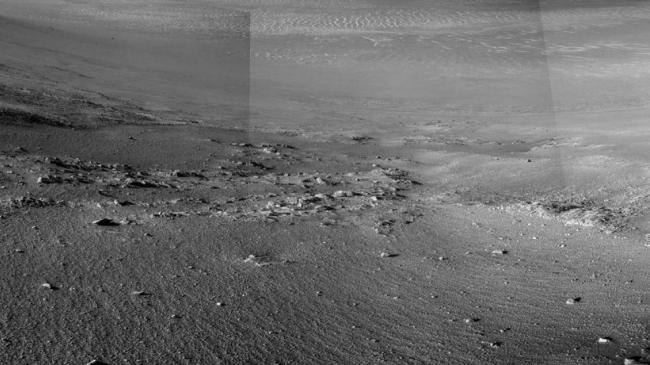
Long-lived Mars Rover opportunity keeps finding surprises
Washington, Feb 17 (IBNS): NASA's Mars Exploration Rover Opportunity keeps providing surprises about the Red Planet, most recently with observations of possible "rock stripes."
The ground texture seen in recent images from the rover resembles a smudged version of very distinctive stone stripes on some mountain slopes on Earth that result from repeated cycles of freezing and thawing of wet soil. But it might also be due to wind, downhill transport, other processes or a combination.
Opportunity landed on Mars in January 2004. As it reaches the 5,000th Martian day, or sol, of what was planned as a 90-sol mission (see related story), it is investigating a channel called "Perseverance Valley," which descends the inboard slope of the western rim of Endeavour Crater.
"Perseverance Valley is a special place, like having a new mission again after all these years," said Opportunity Deputy Principal Investigator Ray Arvidson of Washington University in St. Louis. "We already knew it was unlike any place any Mars rover has seen before, even if we don't yet know how it formed, and now we're seeing surfaces that look like stone stripes. It's mysterious. It's exciting. I think the set of observations we'll get will enable us to understand it."
On some slopes within the valley, the soil and gravel particles appear to have become organized into narrow rows or corrugations, parallel to the slope, alternating between rows with more gravel and rows with less.
The origin of the whole valley is uncertain. Rover-team scientists are analyzing various clues that suggest actions of water, wind or ice. They are also considering a range of possible explanations for the stripes, and remain uncertain about whether this texture results from processes of relatively modern Mars or a much older Mars.
Other lines of evidence have convinced Mars experts that, on a scale of hundreds of thousands of years, Mars goes through cycles when the tilt or obliquity of its axis increases so much that some of the water now frozen at the poles vaporizes into the atmosphere and then becomes snow or frost accumulating nearer the equator.
"One possible explanation of these stripes is that they are relics from a time of greater obliquity when snow packs on the rim seasonally melted enough to moisten the soil, and then freeze-thaw cycles organized the small rocks into stripes," Arvidson said. "Gravitational downhill movement may be diffusing them so they don't look as crisp as when they were fresh."
Bernard Hallet of the University of Washington, Seattle, agrees the alignments seen in images of Perseverance Valley are not as distinctive as the stone stripes he has studied on Earth. Field measurements on Earth, near the summit of Hawaii's Mauna Kea where the soil freezes every night but is often dry, have documented how those form when temperature and ground conditions are right: Soils with a mix of silt, sand and gravel expand more where the finer-grain material is most prevalent and retains more water. Freezing expands the soil, pushing larger particles up. If they move to the side, as well as down the general slope, due to gravity or wind, they tend to move away from the finer-grain concentrations and stretch out downslope. Where larger particles become more concentrated, the ground expands less. The process repeats hundreds or thousands of times, and the pattern self-organizes into alternating stripes.
Perseverance Valley holds rocks carved by sand blowing uphill from the crater floor, and wind might also be the key in sorting larger particles into rows parallel to the slope.
"Debris from relatively fresh impact craters is scattered over the surface of the area, complicating assessment of effects of wind," said Opportunity science-team member Robert Sullivan of Cornell University, Ithaca, New York. "I don't know what these stripes are, and I don't think anyone else knows for sure what they are, so we're entertaining multiple hypotheses and gathering more data to figure it out."
Image Credits: NASA/JPL-Caltech
Support Our Journalism
We cannot do without you.. your contribution supports unbiased journalism
IBNS is not driven by any ism- not wokeism, not racism, not skewed secularism, not hyper right-wing or left liberal ideals, nor by any hardline religious beliefs or hyper nationalism. We want to serve you good old objective news, as they are. We do not judge or preach. We let people decide for themselves. We only try to present factual and well-sourced news.







